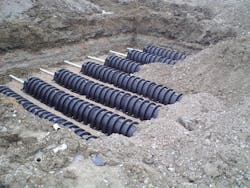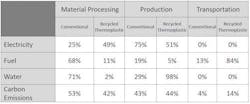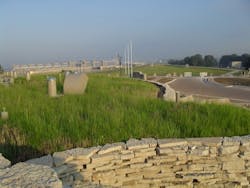About the author:
Eoghan O’Connor is sales and technical support specialist for Infiltrator Water Technologies. O’Connor can be reached at [email protected].
With growing concern over natural resource consumption, climate change has led to an initiative to eliminate the negative environmental impacts associated with the construction and daily operation of homes and businesses. Environmental sustainability increasingly is factored into design because it provides tangible benefits, including reduced operating costs and positive appeal to consumers, communities and business owners. In the water and wastewater arena, sustainable decentralized wastewater treatment systems provide reliable treatment in a compact space or a cluster design that serves a community and replenishes aquifers by returning the treated effluent close to the point of origin. By eliminating the transport of wastewater to a centralized facility, these systems can reduce the energy footprint of wastewater treatment as compared to the centralized model.
Sustainability Certifications & Standards
Several voluntary sustainability standards and certifications focus heavily on water. RELi, the resilient design standard, awards points to projects integrating onsite tertiary treatment of wastewater. WELL encourages eligible buildings to incorporate water quality monitoring and treatment. The Living Building Challenge requires 100% of a project’s water demand to be “harvested” and all effluent to be treated on site.
Leadership in Energy and Environmental Design (LEED) is the most widely adopted environmental building standard. Wastewater can be an asset to LEED credits for a sustainable building project. LEED for neighborhood development includes a wastewater management credit. Projects pursuing this credit earn up to two points (out of 100) for onsite reuse of at least 25% of the development’s wastewater volume.
The materials and resources (MR) credit category included in LEED New Construction (NC) is the water and wastewater industry’s easiest integration with LEED, and it “focuses on minimizing impacts associated with the extraction, processing, transport, maintenance and disposal of building products.” Manufacturer innovation drives performance in this category. Products that quantify their environmental impact through an environmental product declaration or their chemical composition through a health product declaration can help earn points for a project seeking LEED certification. Additional manufacturer-led environmental initiatives such as incorporating recycled content or establishing a take-back program for end-of-life products also can provide benefits to LEED projects.
Sustainability of Decentralized Systems
When adequately designed and installed, decentralized wastewater systems can treat and process large quantities of wastewater into the underlying soils, making this option a passive and sustainable form of aquifer recharge. Rather than partially or fully treating wastewater effluent and then discharging it to a surface pond or injection well before recharging the aquifer, decentralized systems can provide both wastewater treatment and groundwater recharge in one step. Through this sustainable practice, the replenished aquifer then can supply wells, recharge wetlands for wildlife, maintain base flow, and in the case of coastal cities and towns, counteract saltwater intrusion.
Additionally, the effluent does not need to be conveyed major distances to a centralized wastewater treatment plant (WWTP), saving energy and water resources and avoiding the potential negative effects of gathering all the wastewater into one localized area.
Effects of Decentralized Systems on LEED Certification
There are several LEED credit areas that a decentralized approach to wastewater treatment may impact. Should a site choose to seek LEED accreditation while using onsite wastewater treatment, these options should provide direction for architects, developers and wastewater designers working to integrate the wastewater treatment system into the project LEED certification.
Certain areas of LEED NC aim to keep the development area as small and efficient as possible to conserve existing natural areas. For this reason, the size and location of a wastewater treatment system can be impactful. Although land use is not always a strength for onsite septic systems, modern-day systems have evolved far beyond the earlier concrete tank and stone-and-pipe leach field. Advances in septic technologies and plastics manufacturing have opened the gates to alternative and advanced products with better performance, often in a smaller footprint.
For example, due to increased infiltration efficiency, a chamber drain field can be designed at up to a 50% size reduction in some jurisdictions. Not only does this reduce the land consumption required for the system, but it also allows for localized treatment at sites that previously had few, if any, wastewater treatment options. Additionally, the area above a septic system often can be restored with septic-friendly native vegetation or used as open or recreational space.
Consider the LEED Topics
There are a handful of LEED topics that may be addressed by decentralized treatment.
Sustainable sites. This topic aims to limit the overall area that becomes developed. Advanced decentralized treatment systems that offer a small footprint can reduce the development area and may be an asset to obtaining this credit. Also mentioned is the returning of previously removed native vegetation to the area. If the right vegetation is chosen, the area above the decentralized wastewater treatment system could meet this criterion.
Water efficiency: This credit area mentions recharging the local aquifer, which, as mentioned above, is inherent in the way decentralized systems function. Additionally, decentralized treatment may use less water to convey waste compared to moving waste all the way to the WWTP. This reduction in water use and, potentially, energy may impact the performance of the building as it applies to water efficiency. Also, systems that include a grey water reuse system can be favorably viewed related to water efficiency.
Materials & resources: This credit area mentions recycled content. LEED awards points for choosing products and manufacturers that make sustainable products in a sustainable manner. Infiltrator Water Technologies, for instance, manufactures products from recycled content, which can help in attaining the LEED with materials and resources. Other manufacturers have this story to tell as well, and a documented use of recycled content can be a potential benefit toward gaining LEED certification points.
Energy & atmosphere: The overall energy efficiency of a facility is an important consideration for LEED. Several LEED credits deal with this issue. Research demonstrates that decentralized treatment systems installed onsite offer a reduction in energy use over transporting waste to a centralized sewer. In many cases, on site systems can be fed solely by gravity, also reducing the overall energy impact and carbon footprint.
LEED Gold Example
The Jerry F. Costello Confluence Field Station is part of the National Great Rivers Research and Education Center in Alton, Ill., and serves as a model of green construction, with minimal environmental impact, integrated renewable energy systems and internal recycling systems. The architecture of the building complements the surrounding environment and minimizes visual intrusion on the landscape, while sustainable design features reduce the physical and environmental impacts of the facility. The building received LEED Gold Certification.
The wastewater treatment design is an engineered wetland treatment system, which includes Infiltrator Quick4 Equalizer 36 chambers installed in the infiltration bed disposal system and enables the return of the treated wastewater into the soil. The reuse system design features a two-stage tertiary and secondary wetland treatment system with ultraviolet disinfection, and the subsurface wetland cells incorporate native plants in the design.
Infiltrator Quick4 Equalizer 24 chambers are utilized at the influent and effluent ends of the engineered wetland system. The chambers are a suitable choice due to the sensitive ecosystem environment and because they are manufactured from recycled materials. Ultraviolet treatment and ultrafilter treatment also are incorporated, as well as a 5,000-gal grey water storage tank and system to feed toilets and urinals for flushing and also to facilitate external water recycling.
Conclusion
The LEED standards are excellent sustainable building guidelines, even for projects not pursuing the full, rigorous certification process. Sustainable building practices— including water efficiency and reuse, site maximization and open space, and a reduced carbon footprint—are beneficial to the environment and appealing to potential project owners and
users.


